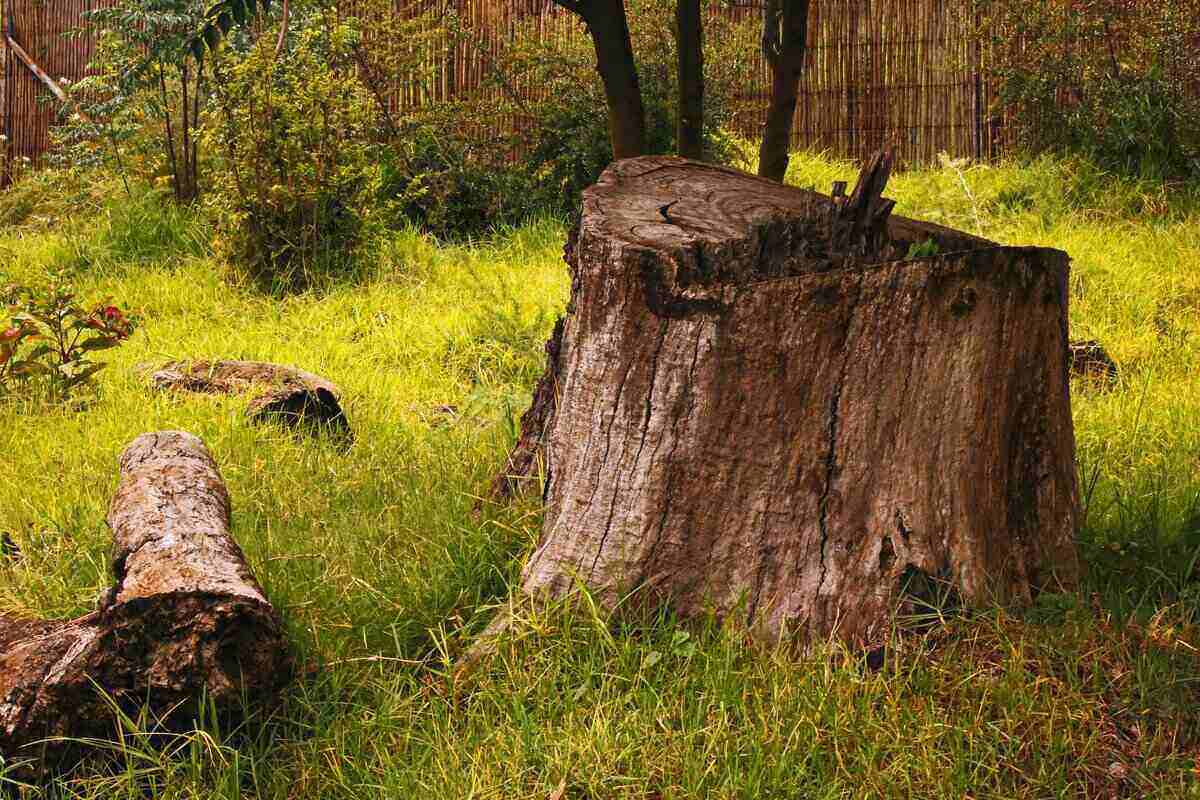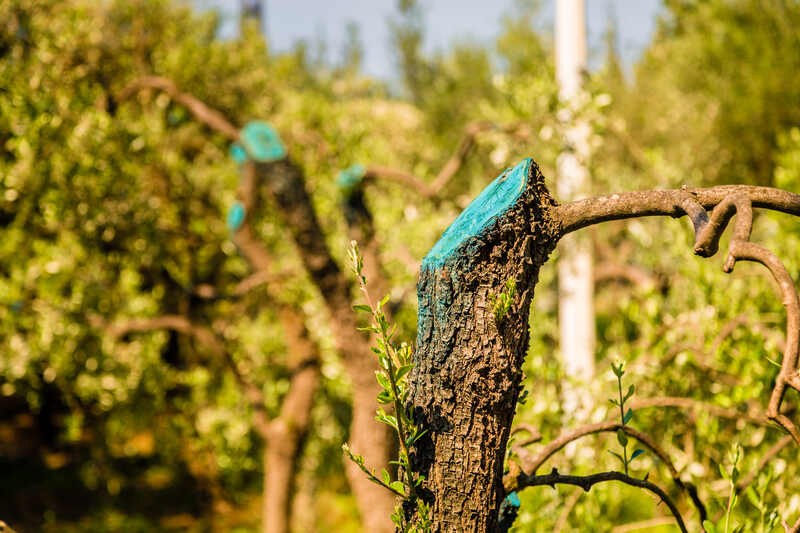
For a long time, it was common practice to use a pruning sealer like tree tar when trimming trees — a seemingly common-sense practice recommended by trained arborists and nursery workers alike. Today, homeowners are learning why painting on tree pruning sealer is a bad idea.
Generations of homeowners grew up believing that painting on an application of pruning sealant on tree limbs/branches was an integral part of “safe” tree pruning. No longer. “Current best practices no longer recommend applying sealants [pruning spray or pruning paste] to tree wounds,” says Karl Flocke, a woodland ecologist who works for the Texas A&M Forest Service.
So let’s talk about why it’s now considered a gardening myth and how yesterday’s tree bandage became today’s bad practice.
What is a Tree Pruning Sealer?
A tree pruning sealer is a specially designed waterproof product that is applied via aerosol spray or painted on with a brush. It is used for the exposed cut on a limb or tree branch after pruning. For many, many years — and still to this day in some cases — people were told by an arborist that tree wounds had to be covered with a sealant.
A tree pruning sealant is a bandage of sorts meant to cover the wound. How does this “bandage” help a tree to heal? The packaging makes a few claims:
- Aids in the healing of pruning cuts
- Minimizes sap loss
- Protects trees from decay, insects, and fungi
It was an easy DIY project, and the product was (and still is) in stock at all garden and big box stores, so it became ingrained as a habit for homeowners.
While good in theory, scientific research conducted by Alex Shigo of the U.S. Forest Service in the late 1970s explained that pruning cuts should not be painted. Rather, the tree should be left to heal through its own devices after you prune it.
He emphasized the importance of following proper pruning practices. Let a fresh cut heal naturally instead of covering it with a wound sealer, he urged.
Why Tree Sealant Isn’t Necessary

Later studies confirmed Shigo’s work. Today’s arborists are trained to consider pruning sealers bad industry practice because they make it harder for trees to recover after pruning.
It’s important to understand that trees don’t really heal after they have been damaged. Instead, they isolate damage through a process called compartmentalization.
Callus tissue develops at the edge of the wound and gradually grows in toward the center. When trees are pruned correctly, this new growth eventually covers the pruning wounds, protecting the damaged trees.
These sealant products are typically petroleum-based, although some may contain asphalt — and actually trap moisture inside the tree wound, which may encourage more problems instead of preventing them.
Some products that exist tout natural ingredients such as collagen, pectin, or aloe vera. Unfortunately, there isn’t any scientific proof that they benefit the tree, either.
The petroleum and asphalt-based wound dressings are known to:
- Seal in moisture and decay
- Sometimes serve as a food source for pathogens
- Prevent wound wood from forming
- Inhibit compartmentalization
- Eventually crack, exposing the tree to pathogens
Tree Sealant Impact on Human Health
Tree sealants are no fun for humans, either.
These products often contain a volatile combination of asphalt and solvent and some are considered hazardous by OSHA.
According to the safety data sheet for one popular product, tree pruning sealers may:
- Contain gas under pressure and may explode if heated
- Cause serious eye irritation
- Cause skin irritation
- May cause genetic defects
- May cause cancer
For this product, the label advises users to wear skin and eye protection and store it in a cool, well-ventilated place.
So after learning those tidbits, it’s a bit easier to see why you should stop using pruning sealer on your trees.
Should You Seal Pruned Limbs at All?
The short answer to this is no! You should not use pruning paint to seal pruned limbs at all. They are better left to undergo natural healing through their own plant defense mechanisms.
Plus, why would you want to put a product on your tree that can also be used to seal and waterproof rain gutters, roof flashings, wooden planters, the underside of a lawn mower deck, or even small sections of asphalt driveways?
If something claims to be effective for these other outdoor uses, don’t put it on a living tree. In my opinion, it’s better to leave the tree be so it can “fix” itself.
Instead of sealing pruning wounds, it’s better to implement prevention. You can minimize problems that may stem from pruning by following these tips:
- Properly sterilize all pruning tools with a 70% isopropyl alcohol solution before and after using them. That applies regardless of the time of year you are pruning, or the type of tree you are working on.
- Control the spread of disease by properly disposing of all problematic limbs/branches after pruning. Use only disease-free mulches or compost.
- Make clean, smooth cuts, making sure to not leave stubs, but keep the branch collar intact.
- Prune trees at the proper time, preferably in the spring when they are still dormant and haven’t started forming leaves. This makes them less susceptible to infestations or infections.
The Exception: Oak Trees
Oak trees in about 24 states, from the middle-Eastern states south through Texas, can suffer from oak wilt. The damage done can be both devastating and irreversible.
The fungus that causes the disease spreads from tree to tree, carried by Nitidulid beetles attracted to the smell of the tree’s sap. The insects will then move to another tree, laden with oak wilt fungus spores, and spread the disease. So quickly covering any pruned branches will cover that fresh-sap smell before the beetles come a-running.
“Most forms of paint work equally well, and there is no need for specialized rubberized or petroleum sealants,” says Texas A&M’s Flocke.
He’s stationed in Austin, Texas, where oak tree wilt is such a concern that pruning oaks is discouraged from February through June. “The wound paint is only necessary for the first two to four days after the cut has been made,” Flocke says, “so there is no need to reapply paint or to go out and paint old wounds.”
How to Remove Pruning Sealer
I’m sure you’re now asking yourself if using a pruning sealer has caused irreparable damage to your trees. You may also wonder if you should consider removing it. This isn’t so easy to answer, and surprisingly, there isn’t much discussion about it online.
I recommend if your trees’ pruning cuts had a tree sealer applied to them, remove it if possible. Due to the chemical composition of the sealer, you can’t simply peel it off and throw it away, unfortunately.
Here is how to remove pruning sealer from your tree:
- Make a new pruning cut
- Remove the paint, and create a new, open wound.
Pro Tip: A new pruning cut wouldn’t need to be made much below the old one. Perhaps a quarter to a half of an inch is good if there’s enough wood to do that. Make sure it’s a clean, straight cut and your tools are sterilized.
This new wound will trigger the tree to begin the process of compartmentalization, forming a new callus to protect the wound naturally.
FAQ
What is the Best Time of Year to Prune Deciduous Trees?
Prune healthy, deciduous tree branches in late fall to winter in most cases. Prune dead or dying branches any time of year.
Why late fall to winter? During this time, deciduous trees have lost their leaves and are in a state of dormancy. This is ideal for two reasons:
First: It’s easier to see the form of the tree and to select the branches that need to be pruned.
Second: Wound compartmentalization happens most quickly right before new spring growth appears.
Should I Use a Pruning Sealer on Oak Trees?
There’s an exception to every rule, and oak trees are it. Oak trees in about 24 states can suffer from a fungus called oak wilt. When pruning, apply a tree sealant spray to each wound as soon as you make the cut so none are missed.
Note: Pruning paint for oak trees is also acceptable if you don’t have a spray application. Always read the manufacturer’s label for instructions on how to seal a tree wound.
What Should I Do After Pruning My Tree?
Water regularly as your trees will need plenty of water to help them heal. Aerate any compacted soil around the tree to promote air circulation and add fertilizer to encourage new growth.
Hire a Professional
Pruning trees can be a daunting task, especially if you were inspired to plant an orchard. When in doubt, the best solution is to hire a tree care professional to handle the dirty work while you enjoy the shade.
Main image credits: Lynn Greyling / PublicDomainPictures / CC0 1.0